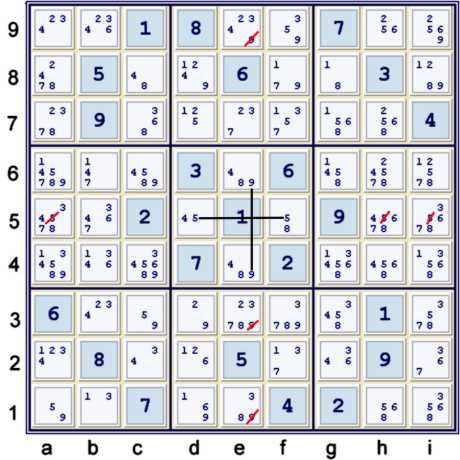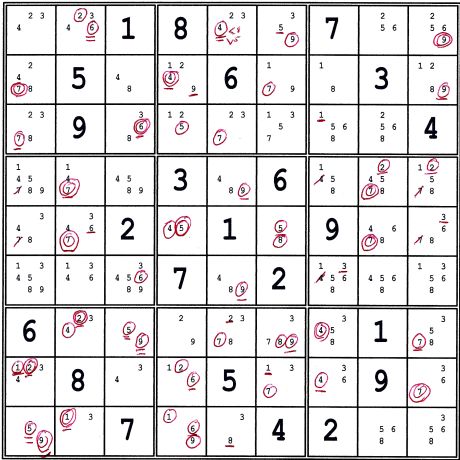The following illustrated proof for the
Tough Sudoku of March 31, 2008 employs
a small group of Sudoku techniques, tips and tricks: Hidden Pairs, Hidden Triplet, Locked Candidates,
and Alternating Inference Chains.
Previous blog pages may be helpful. Links to these pages are found to the right, under
Sudoku Techniques. This list is getting long, so specifically, one may want
to refer to the following previous blog pages:
Many steps not illustrated are possible. To show every possible
step is, well, just overkill. However, this page illustrates sufficient deduced elimination steps
to both solve the puzzle, and also to prove a unique solution.
The illustrations of forbidding chains, also called
Alternating Inference Chains (AIC), shown below will share this key:
- black line = strong inference performed upon a set (strong link)
- red line = weak inference performed upon a set (weak link)
- black containers define a partioning of a strong set(s)
- candidates crossed out in red = candidates proven false
Please be aware that, for me, strong and weak need not be mutually exclusive properties.
Style Change
Previously, I had abandoned using the chessboard algebraic notation in favor of the more common rc notation. However,
since many people have begun again to post proofs on the tough pages, I am hereby returning to algebraic notation. I will
retain some of the Eureka-like qualities of writing AICs, though. Hopefully, this does not create too much confusion for
those from either group. Illustrations will include the cell descriptive labels to help with interpretation.
The Puzzle
Zero Unique Possibilities are available here. However, I can identify a Hidden Pair without
considering the Possibility Matrix. Note:
- (5)e2,(9)h2
- (5)b8, (9)b7
- => (5)a1=(5-9)c3=(9)a1.
- => step 1a Hidden pair 59 at a1,c3
- => a1,c3 are limited to only 5,9
Steps 1b & 1c - Locked Candidates 5 & 9

Above, two easy steps are illustrated:
- step 1b Locked candidate 5 at df5 in box e5 (box 5) => ahi5≠5
- step 1c Locked candidate 9 at eh6 in box e5 (box 5) => e139≠9
The symmetry of these eliminations, plus the already found Hidden Pair 59 in
step 1a caused me to muse for
a bit about Uniqueness of solution with this puzzle. What follows immediately below is basically a digression, but it
helps to reveal how I quickly came to solve this puzzle.
A uniqueness digression
Once upon a time, I stayed away from Uniqueness of Solution as a solving technique. Eventually, I changed my mind. The
main reason for changing my mind follows:
- Every puzzle that I have tried to solve over the last few years had exactly one solution
- My mind processes much about pattern recognition without my awareness
- The process of knowing where to look is filtered by my experience
- => My experience is inescapably prejudiced by uniqueness of solution
- => I am using uniqueness of solution, whether I want to or not
- If I cannot avoid using uniqueness of solution behind the scenes in my mind, I may as well use it explicitly.
Puzzle Mark-up
Below, find a typical puzzle Mark-up. Note that I include the eliminations from three more locked candidate steps.
These steps are not required to solve this puzzle. However, they did help me locate where to look.

While making the puzzle marks, I thought about a possible MUGgish deduction. Also, one could have viewed it as a BUG.
However, what I found with very little thought was a long chain involving an Almost Unique Rectangle. Although I do
not use the following chain in my solution, it quickly let me see how to proceed with this puzzle. There were several other
chains that I uncovered during the process of marking the puzzle. Typically, a small amount of time investigating potential
chains during the puzzle mark-up phase pays significant dividends later. The puzzle becomes burned into my brain. I can then
manipulate chains with much greater ease. Here is what I found:
- (Triplet 458)adf5=(3)a5-(3)a79=(hidden pair 36)b9c7-(2)b9=(2)b3-(2=9)d3-(9)c3=(Xwing 9)ce46
- With an Xwing contained in two boxes, there may exist a hidden AUR deduction. Here I continued:
- -(Xwing 8)ce46=[(8)af5=(hidden triplet 589)a146-(1)a46=(1-2)a2.....]
I did not make any eliminations, nor reach any certain conclusions. However, I exposed some potential puzzle weaknesses. This
is often the case with musings. Now, the finished puzzle mark-up combined with that chain going nowhere focused my search.
Specically, I know now that (1)box b2 determination will significantly unlock the puzzle. Fortunately,
this is easily resolved. In fact, I did not need to complete the puzzle mark-up - but decided to do so for illustration purposes.
Do not worry if you cannot follow my logic above. It is the result of solving far too many Sudokus. What follows below
can be located without the Uniqueness Digression. However, I wanted to include the digression, as often I am asked to explain
how to determine where to look. The answer is not simple, nor always the same. However, in a general fashion it can be said
to be exploring chain snippets.
Step 1d - A Hidden Y Wing Style
Y wing style merely refers to any chain that contains exactly three strong inferences. The logic below is exactly like
a standard Y wing, except that in this case only hidden strengths are considered. The mark-up exposes hidden strengths, and
their intersections. In practice, I see from the mark-up (1)b1%chain.

Above, find:
- (2)a2=(2-6)d2=(6-1)d1=(1)b1
- => a2≠1
Thus, one cell is solved: (1)b1 %box.
step 2a - Hidden Triple 159
On the left, since candidates 1,5,9 are limited to three locations in column a, no other candidates can exist in cells
a1,a4,a6. After making these eliminations, my previous musings ascertain that (8)a5=(8)f5. In fact, I actually conclude in
my head (8)a5%chain. However, there is a short path to reach eventually most of the same conclusions. The musings merely focused
my search, again. The result of this directed search can be seen in the next step.
step 2b - An easy depth 4 chain.
After eliminating (8)from a46, the relationship (8)a5=(8)a78 is created. This relationship has a clear continuation in
every direction. On the left, I have illustrated one of these:
- (8)a5=(8)a78-(8=4)c8-(4)d8=(4-5)d5=(5)f5
- => f5≠8
From this point, a small cascade of cells can be solved:
- (5)f5 %cell
- (4)d5 %cell
- (4)e9 %box,column
- (8)f3 % column
- (3)e1 %cell
- (5)d7 %column, box
Thus, UP 30.
Step 3 - another easy depth 4 AIC
After solving the cells indicated above, the following new information led me to find the chain below:
- New Bivalue (2=7)e7
- New Bilocation (4)a2=(4)a8

Above, find:
- (2)b3=(2-4)a2=(4-7)a8=(7)f8-(7=2)e7
- => e3≠2
This causes a cascade of mostly naked singles to puzzle completion.
Solution

Below, find the rating data that I think is still relevant for easy tough puzzles:
- Strong inference sets considered: 2+1+1+3+4+4 = 15
- Maximum depth: 4. Twice.
- Rating: .42
A rating of .42, in my experience, means a pleasurable puzzle that will not consume too much time. However, it is also
challenging enough to preclude boredom.